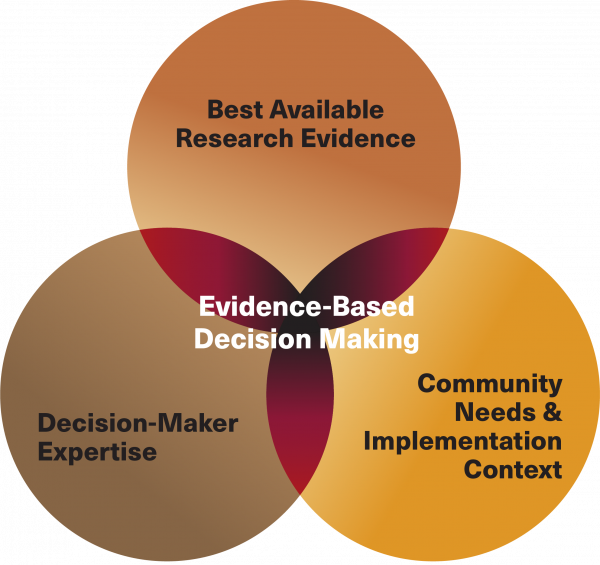
Colorado’s five-year vision for Evidence-Based Decision-Making (EBDM) in policymaking was created collaboratively by members of the executive and legislative branches, non-governmental partners, and the Colorado Evaluation and Action Lab (Colorado Lab). EBDM is recognized as an important means to drive smart state investments, continuous quality improvement, innovation, and meaningful outcomes.
“Realizing this vision depends on creating a culture that values EBDM. This is important because, as the saying goes, ‘culture eats strategy for breakfast’,” says Dr. Courtney Everson, senior researcher/project director for the Colorado Lab. “This means that in addition to EBDM being understood by staff and leadership, they also need to know their EBDM responsibilities in relation to their roles. As well, there should be structures and processes in place to make consistent participation in EBDM feasible and sustainable over time.”
Creating this type of culture begins with a common understanding of what EBDM is and how to achieve it (Feature 1 in the table below). The Colorado Lab is leading two efforts to build this shared fluency and equip decision-makers, agency leadership, and staff in confidently participating in EBDM.
The Colorado Evaluation and Action Lab received philanthropic support to facilitate the development of a commonly accepted vision for Colorado’s approach to evidence-based decision-making (EBDM). This collaborative endeavor was contributed to by the Governor’s Office of State Planning and Budgeting, Office of Operations, and Office of Information Technology; General Assembly members; Joint Budget Committee staff; several state Departments; and the Colorado Evidence-Based Policy Collaborative. Collectively, our aim was to provide Colorado policy leaders and influencers with a clear, consistent approach to drive smart state investments, continuous quality improvement, innovation, and meaningful outcomes.

EBDM 101 Learning & Dialogue Sessions
The Colorado Lab has been hosting “EBDM 101 Learning & Dialogue Sessions,” presenting to an array of state policy leaders, including the Office of State Planning and Budgeting and agency performance management staff through the Governor’s Operations Team. These learning sessions provide foundational information about the EBDM vision, along with the opportunity to begin unpacking what the vision means for each agency or team in practice.
“This is complicated work and it’s important to put out a ‘welcome mat’,” said Dr. Kristin Klopfenstein, director of the Colorado Lab. “We want people to be intrigued, to see the value of this approach, and to understand how EBDM can help them and their colleagues further strengthen the work they’re doing.”
Each session provides foundational information—including the what, why, and how of EBDM—and is tailored to meet the targeted needs of individual agencies or teams. From these foundations, agencies and organizations are then equipped to engage the Effective Leadership through Data training offered by the Colorado Lab as part of EBDM culture building.
What – EBDM recognizes that research evidence is not the only contributing factor to policymaking decisions. Other equally important and intersecting factors include decision-makers’ expertise, community voice, and feasibility of implementation.
Why – An EBDM culture informs the efficient and effective use of resources, drives better outcomes, and its collective approach leads to sustained change.
How – An EBDM culture facilitates cross-sector partners in working together to more fully and effectively address priority issues, and it provides pathways to align roles and responsibilities. By answering the question “what does my piece of the puzzle look like?” government and non-governmental partners can drive collective action that improves the lives of Coloradans.

Colorado EBDM Glossary
To further support decision-makers, agency leadership, and staff in gaining a common understanding of EBDM, the Colorado Lab developed the Colorado EBDM Glossary. “This tool promotes a shared understanding of key concepts. Our aim is to decrease disconnects, helping people to get on the same page so that they can work together more efficiently and effectively,” Dr. Klopfenstein says.
Each definition is developed based on a literature review together with input from subject matter experts and practitioners. Collaborators in glossary development include staff from the Governor’s Office, Joint Budget Committee staff, agency leadership, and members of the Colorado Evidence-Based Policy Collaborative. The living document is updated quarterly and key stakeholders are notified of new terms and definitions. The goal is to have a one-stop-shop that can promote adoption and alignment of terms across current statutorily-defined, rule-defined, and commonly-used definitions in Colorado and across the nation.
We welcome and encourage you to learn more about EBDM, including how to create a culture that values and activates EBDM. Please reach out to Dr. Courtney Everson to schedule a Colorado Lab-hosted EBDM 101 Learning & Dialogue Session or to discuss other ways to get involved.
This glossary is a living document. If you have feedback on the definitions, would like to request that additional terms be added, or would like to receive updated versions of the glossary, please contact courtney@coloradolab.org.
In our next blog post, we’ll explore the second and third defining features of an EBDM culture—a commitment to and consistent participation, paired with the resources, skills, and time needed to advance EBDM strategies.